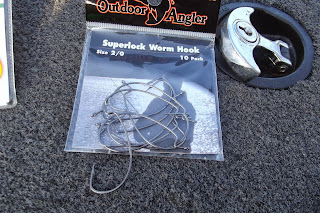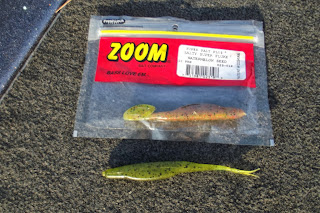These are just a few of the formulations - there are way to many to show on here, but this is one of the best things about soft baits - they are extremely adaptable in form as well as color and size. The three pictured below are all 5" baits, which seems to be a good average size for soft baits, but they are also made in extremely small sizes and jumbo, bucket-mouth sizes.
First, a quick word on knots - I like a Palomar knot (brought to you by the folks at Take Me Fishing - they have an excellent knots section!) or a double looped knot (sometimes called a Trilene Knot, brought to you by NetKnots!)
The rigging choices offered by softbaits are the other ways they are so adaptable to different waters and combinations. They can
be rigged in Carolina or Texas style with various sized weights so that they
can go deep, with weighted hooks, and completely weightless which allows them
to fished as a faux topwater lure, or one which is so near the surface of the
water as to be virtually the same.
We will
start with a technique that is by itself extremely adaptable, the Carolina rig.
 |
| Carolina Rig with Fluke Paddle Tail 5" swimbait, 1/4 ounce weight |
For some reason, a well-made Carolina Rig is almost impossible to buy in the stores unless you are lucky enough to find a very good custom fish shop (like Tackle Town in Pumpkin Station, NC). The Carolina Rig consists of two parts – 1st is a snap swivel used to attach the rig to your line; from the snap swivel there is a leader, usually around 8" with a weight and 1 – 2 colored beads (normally red or orange) on either side of the weight, or below the weight if there is just one bead. I like bullet or barrel weights, usually 1/8th to 1/4 ounce.
This is tied to a barrel swivel, and on the other side of that is a leader (1’ to 3’ long) which ends in a weightless hook. The weight on the front part of the rig will usually be a barrel weight or a bullet weight, and the size of the weight will be determined by the size bait you want to use, your tackle, and how deep you want to fish the bait.
 |
| Shown with different bait, rigged wacky style - weedless hooks are preferred for type of bait rigging |
 |
| These are perfect for the Wacky rig (just hook your softbait through the middle and slow twitch it! |
This is tied
to a barrel swivel, and on the other side of that is a leader (1’ to 3’ long)
which ends in a weightless hook (see top Carolina Rig picture). The weight on the front part of the rig will
usually be a barrel weight or a bullet weight, and the size of the weight will
be determined by the size bait you want to use, your tackle, and how deep you
want to fish the bait.
I know a lot
of people like to use rather large weights on these, and that is usually all
you can find in the stores. I do not like to large a weight – in the one
pictured, it is only XX heavy, which is a perfect weight for my applications.
It allows for deep deployment with a quick sink rate, but is also not too
heavy.
Weightless/Weighted Hook
These are rigged the same - the weight just gives a bit of extra casting power and a quicker sink time, but both of these are very versatile, especially with the twitch receives. The weightless rig can be fished almost like a topwater - the sink time on these is incredible slow, and they make great shallow water finesse baits. Twitching them slowly along docks is a perfect method with these guys.
The weighted hook method is especially useful with swimbaits like this Fluke in muted brown and salmon tones below - this color is great for dirty water or dim days. With a steady retrieve these rigs will stay very close to the surface; dial it in slowly or with variations to determine the depth of the retrieve!
The Carolina Rig
Retrieve
This is
where soft baits really come into their own, and where the Carolina Rig gets a
lot of its adaptability. The first is slow, and very effective in certain
situations – the drop and drag.
 |
| Its a Monster! |
In the drop and drag, the rig is allowed to sink to the bottom of the lake or river, and then using a slow retrieve (sometimes excruciatingly slow), the weight is dragged along the bottom, through mud and over underwater obstacles. Because of the weightless hook, the bait itself floats along behind the weight as it is dragged across the bottom. This retrieve is slow, and can try the patience but when the fish are holding to bottom structure this can be extremely effective. It works in shallow and deeper water. That's how I caught this little guy (picture above)!
Bouncing
This
retrieve looks exactly like it sounds, and makes a Carolina Rig into a fantastic jig rig; after the cast, allow the weight to
fall to the bottom, then with a smooth motion pull the rod from 8 o'clock or 9 o'clock to noon or one o'clock; lower the rob, reel some in and as soon as the weight hits bottom, pull back up - that's how this one got in the boat, dragging it from shallow water off a shelf going down to about 15' deep. You can see the natural colors he was going after - a crawbait in red would be perfect after seeing this!
This one was caught here:
 |
| Cast to the shore, and drag or bounce the Carolina rig back to the boat! |
 |
| Under the tree is a perfect spot for largemouth at the end of summer! |
I cast to near the shore, and then bounced it outwards, past the dock and down the slope - the fish hit it about halfway to the boat, or 20 - 25 feet from shore at about 10' deep.
 |
| And another one, caught the same way |
 |
| Flip a weightless worm under these trees and get ready! |
 |
| This bank is begging for a Carolina Rig bounced along the bottom back towards the boat! |
 |
| Going up against docks works great - let the bait, even lightly weighted ones, sink to the bottom before retrieving! |
 |
| Yes, they are great hooks! |



















